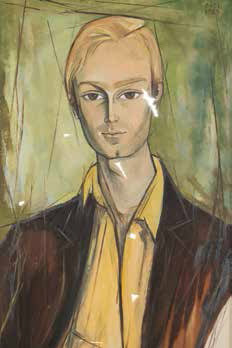
DÉTAIL DE L'OEUVRE ORIGINALE
- Artiste : Cici Sursock - (signature en haut à droite)
- Oeuvre : Portrait de Alfred Sursock Cochrane
- Titre : Cici Sursock 3
- Dimension : 70 x 110 cm
- Collection Roderick Sursock Cochrane
Cici Sursock

Cici Sursock was born in 1923 and was primarily influenced by the 1930s.
The period of the 1930s is epitomized by the conflict between a number of political ideologies, including Marxist Socialism, Capitalist Democracy, and the Totalitarianism of both Communism and Fascism. Artistic output in the United States was heavily impacted at the time by the Great Depression, and a number of artists took to focusing on ideas of
humbleness and the ordinary man.
For the first time in US history, artists began to delve into political subjects and attempted to use their art to impact society. Themes such as poverty, lack of affordable housing, anti-lynching, anti-fascism, and workers’ strikes were predominant in many artists’ work. Surrealism continued to dominate in Europe, and had influence worldwide. Artists such as Frida Kahlo and Diego Riviera in Mexico, worked to integrate the ideas posed by Surrealism into their radical political
philosophies, developing a new kind of magic realism.
In the Soviet Union, Stalin’s government required urgent funds to implement the rapid industrialisation demanded by the first Five Year Plan. It initiated a secret plan to sell off treasures from the State Hermitage Museum in Leningrad (St. Petersburg), including a preliminary list of two hundred and fifty irreplaceable paintings by the Old Masters, a number of which ended up in the collection of Andrew Mellon via the New York based art dealing company, Knoedler. The decade took a sinister turn with the dawn of National Socialism in Germany, followed by Adolf Hitler’s rise to power in 1933. By the end of the decade, the Second World War had begun; which preoccupied both artists and the global population.